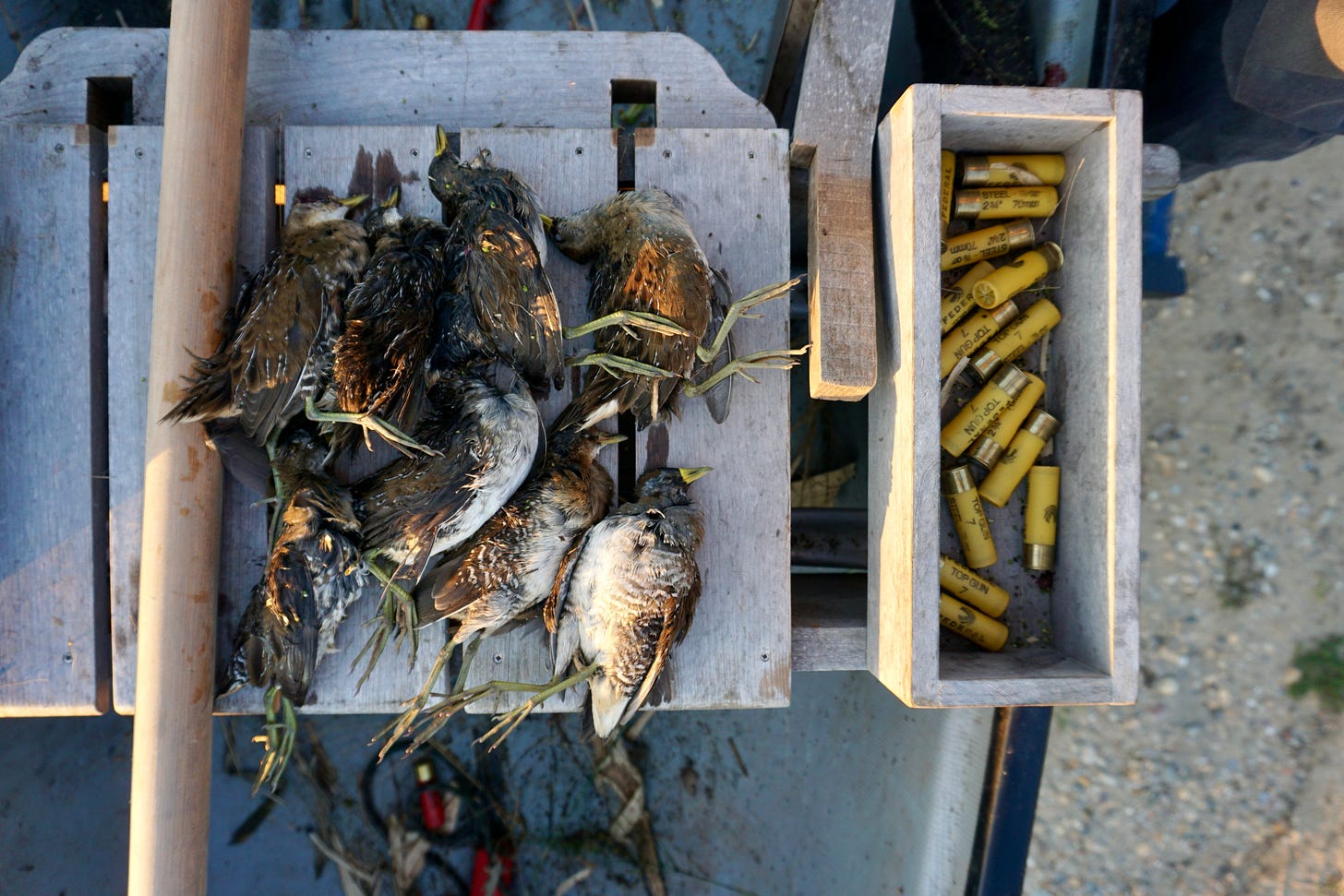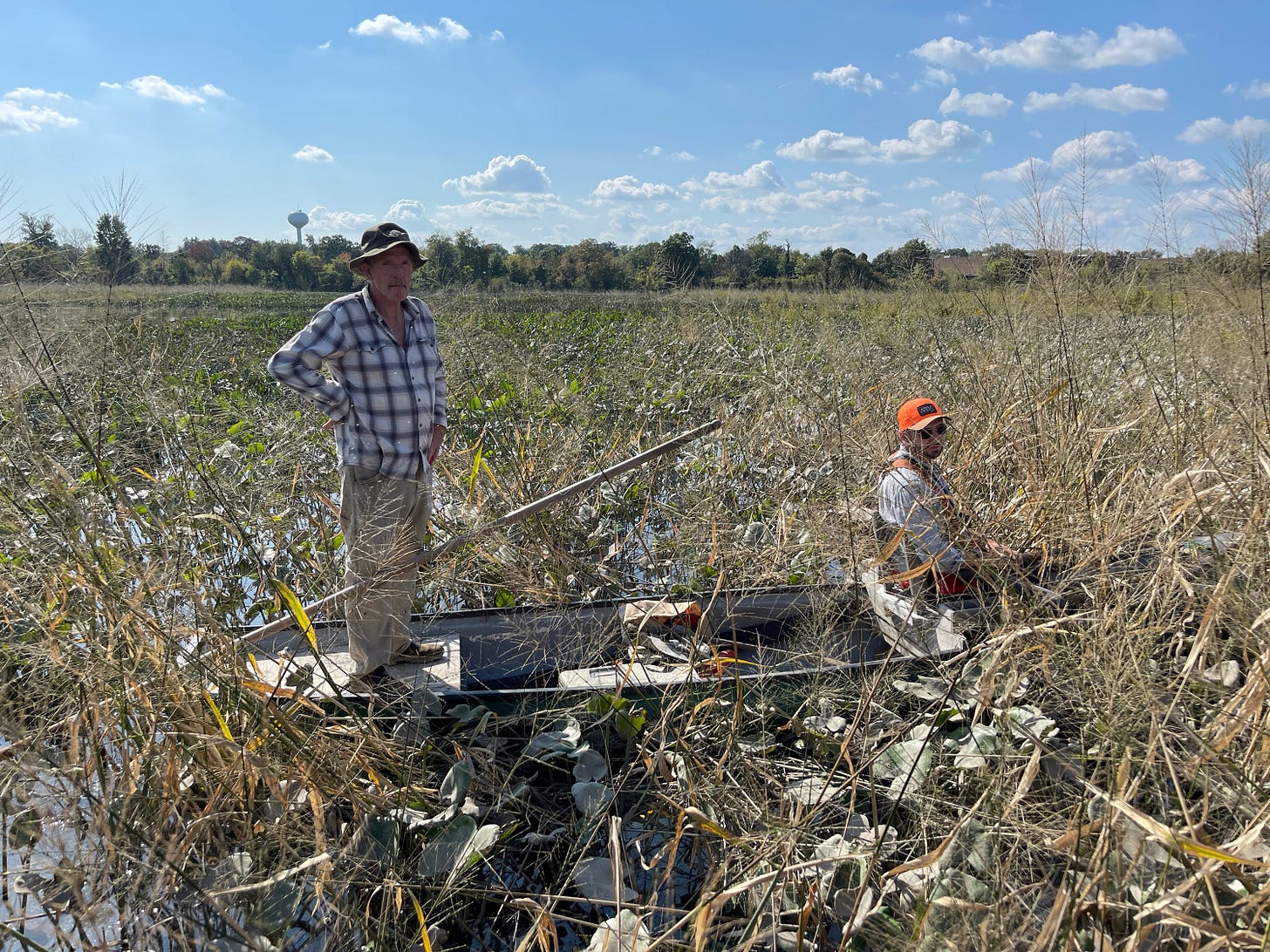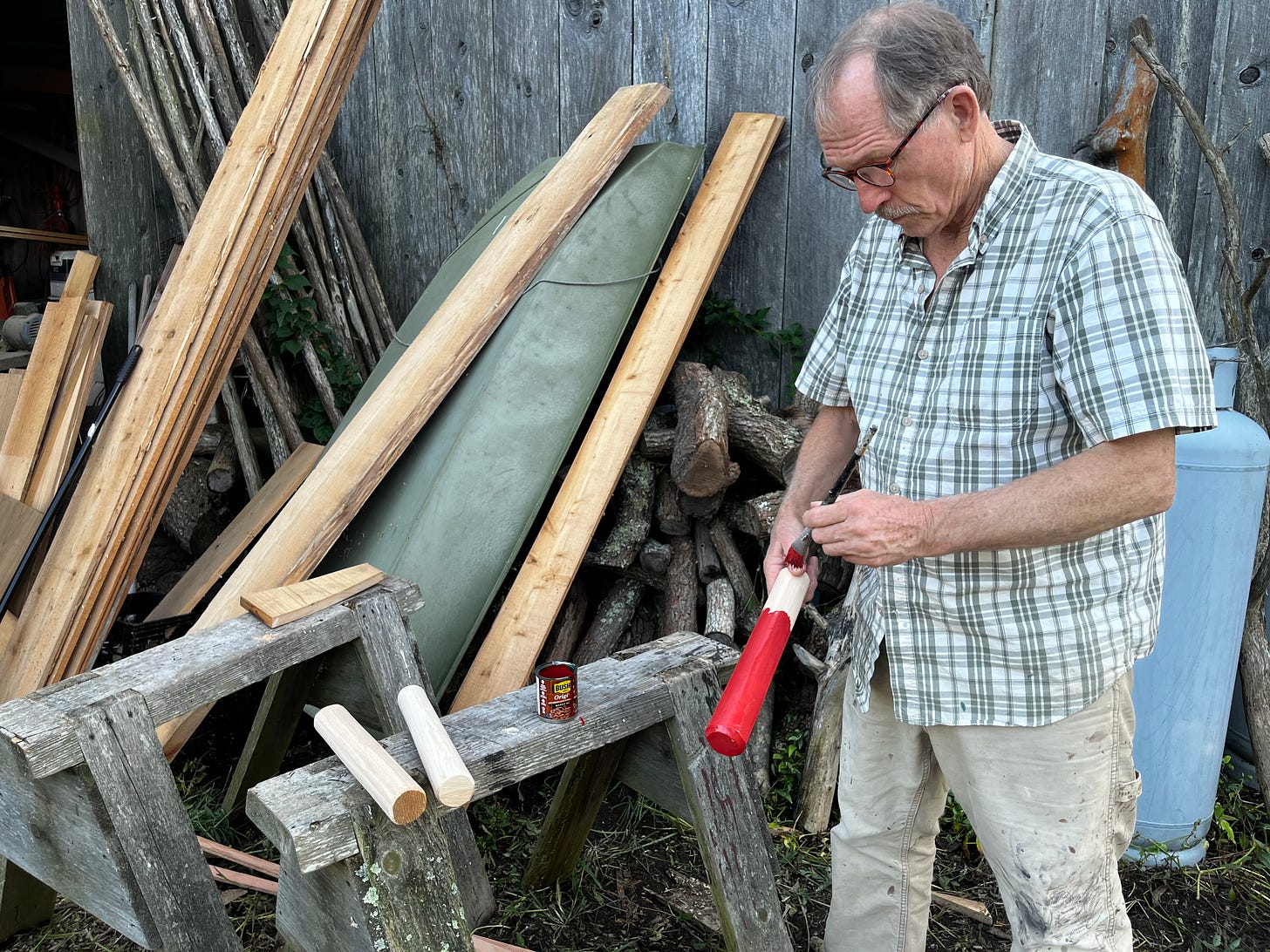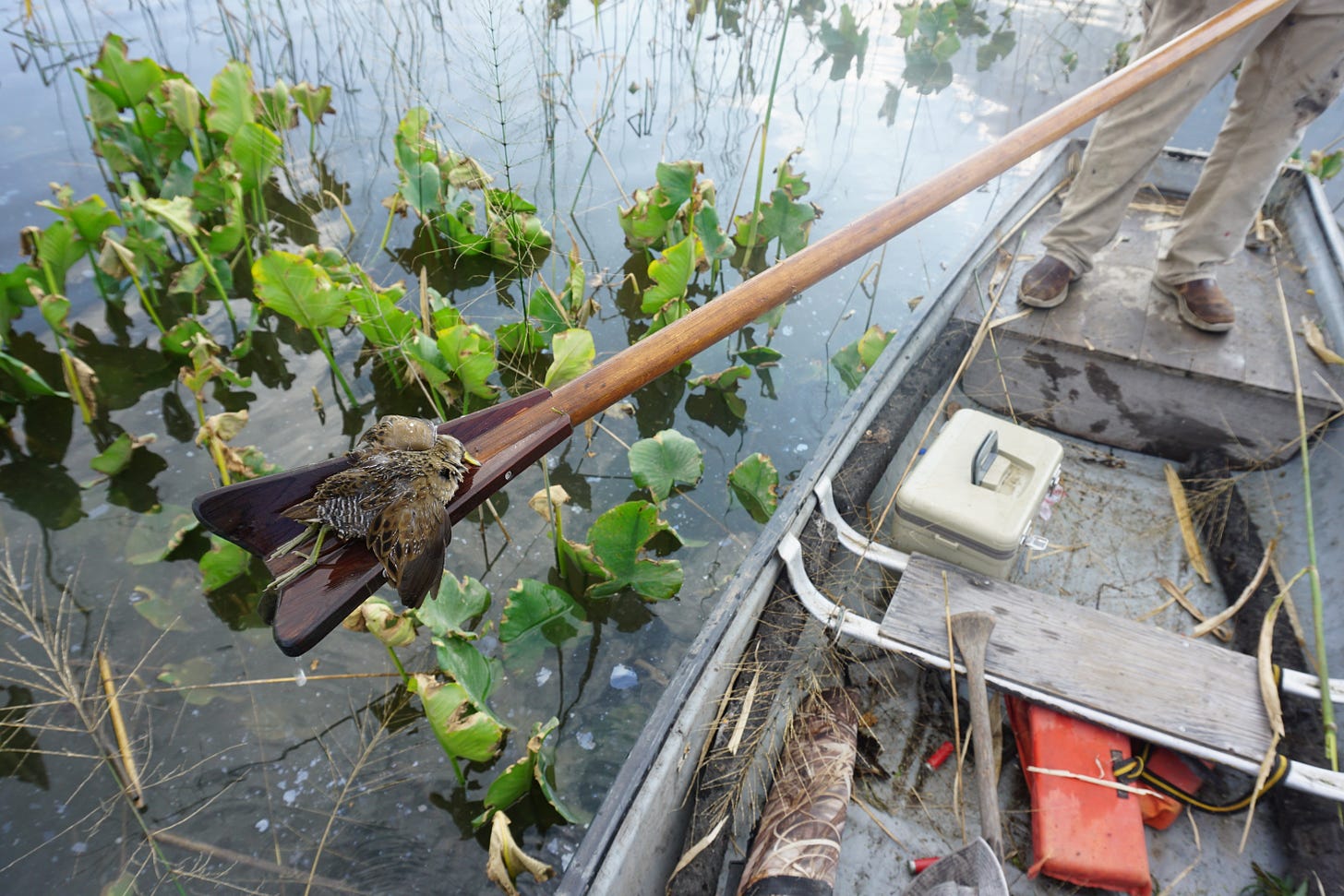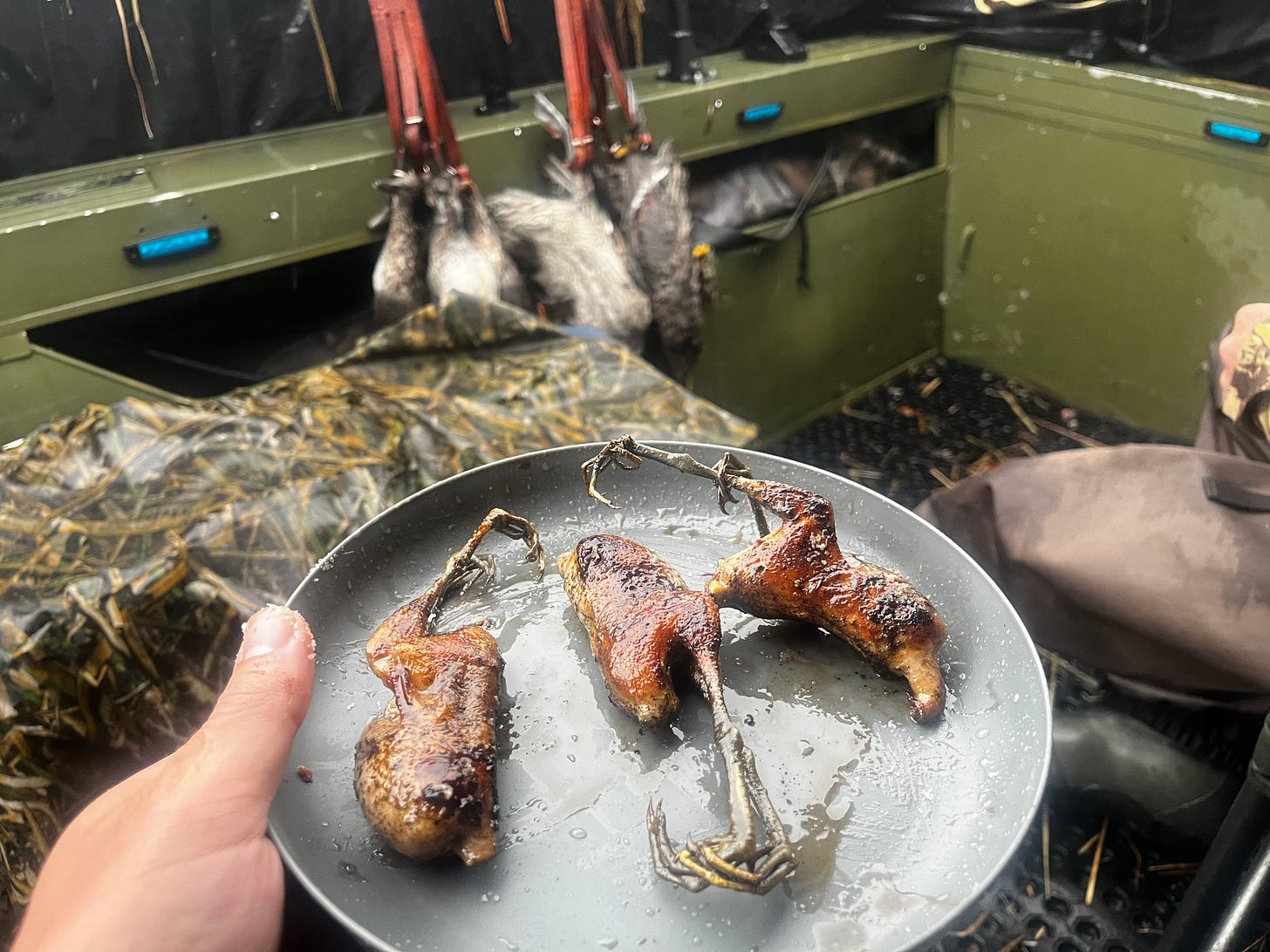Ride the Rails: Two Hours of Obscure Waterfowl Hunting
Poling a skiff for railbirds is a lost art, but a handful of old-school hunters still meet up on the wild rice marshes of New Jersey every year
Jamie Hand is restless. High tide was supposed to hit a half-hour ago. This means one of two things: The tide charts are wrong, or the flood tide we need to hunt railbirds isn't going to arrive.
The birds migrate down the East Coast at the end of every summer, stopping at patches of wild rice. When threatened, they'd rather run than fly, but on a flood tide, there isn't any ground to run on. The birds climb to the ends of the rice stalks and gather on little clumps of dry ground. It's the only time you can really hunt them — and it only lasts two hours. It's also the only time you have enough water to pole a skiff through a rice field. Timing is everything, and you might only get one or two good rail bird hunts a year.
Today isn't all bad, though. In the distance, we can hear our friends Bob White and Bill Effington shooting at sora rails. They're floating through a patch of cattails and rice, and we can tell by the sound of gunfire that they must have enough water to move.
The shots are too much for Hand. Even with the low water, he wants to grind through vegetation and see if we can find a bird. But we're sitting like beached whales in our skiff next to another boat crewed by Frank Bennett Sr and his son Frank Jr.
"Want to push through that patch of daisies?" Hand asks, pointing to a type of plant I'd never seen before. Frank Sr. tells him to wait for more water, but Hand is already pushing our boat forward. As a passenger, I don't have much say in the matter. All I can do is sit at the bow, shotgun in hand.
I feel the boat lurch and hear the hull squeak on the plants below. Then I see Frank Sr. lean hard into his pole and push his boat forward to join us. The two captains hash out a plan on the way — to push side-by-side as if walking up a field full of pheasants. We hear two more shots in the distance, and I look back to see Hand grimace as he pushes us forward with all he's got.
"Turn around and pay attention," he says to me. "I'm feeling birdy."
A Lost Art
Earlier this afternoon, we headed to the marsh with a bit of paint on our fingers. Last night, Hand carved rail bird markers from Atlantic white cedar while I helped paint them. We finished them after dinner, took them out of the damp coastal night air at his New Jersey farm, and set them to dry on a table saw in his decoy shop. Today, we hope to throw them at fallen birds to help us find them in a sea of wild rice.
Hunting for railbirds is one of the most obscure kinds of waterfowl hunting in the country. But in the late 1800s, it was all the rage. Outfitters built camps and upscale hunting lodges up and down the East Coast, from New Jersey to North Carolina. Artists of the time romanticized the sport, and wealthy hunters would travel from around the country to be pushed on a railbird skiff. President Theodore Roosevelt gunned for railbirds, as did President Benjamin Harrison.
By the 1920s, New Jersey was the premier destination for railbird hunting. There, hunters would shoot three kinds of birds: sora or "Carolina" rails, Virginia rails, and Clapper rails. Sora and Virginia rails feed mostly on wild rice, which grows in freshwater. But over the years, development, invasive species, and saltwater encroachment shrunk the vast railbird habitat up and down the coast.
With fewer places to hunt, railbird shooting waned in popularity. And with it went the specialized skill and knowledge of poling a railbird skiff. Today, only a handful of guides and hunters still push for railbirds every autumn. Hand is one of them, along with the band of decoy carvers and boat builders who are with us this afternoon. A trip like this might not exist in 10 years, which is why I've been trying so hard to join them.
I've had the flood tide marked on my calendar for two months. It's hard when I live so far from the coast, but Hand has been keeping an eye on things and calling me with updates. We would have done well if we had been out here the day before. White and Effington limited out in under two hours. By the sound of things, they're on their way to doing that again. But we're still fighting an uphill battle with hardly any water below our boats.
As we approach the daisies, Hand and Frank Sr. adapt our plan. The bit of cover stretches out like a long finger with some water on either side. Bennet pulls his boat to one side while we go to the other. The idea is that any birds hiding out will either have to flush or run to the end of the cover and then flush.
Hand slaps the brush with his pole, and we all hear a peep. "When you hit the brush, a railbird will call," Hand says. "But they don't do that all day. Once the shooting starts, they quiet down."
It isn't long before Hand spots the bird. He can see it running in the brush ahead of us. "Get ready," he says. Frank Sr. and Hand inch forward, and every few feet, they smack the brush with their push poles, trying to get the railbird to break. Then I catch a glimpse of the bird, too. It's dark brown, about the size of a robin, and looks like a big wren with lanky legs. Frank Jr. gets his shotgun ready, and I do the same. We're nearing the end of the finger with a patch of open water ahead of us.
I glance down to make sure I've selected the barrel on my gun with an Improved choke when I hear Hand shout from the back of the boat. "There it is, on the right!" The bird is in mid-flight, and I wheel up to get a bead on it. Just as I do, Frank Jr. pulls the trigger and drops our first sora rail of the day into the water. "Nice shot," Hand says, and he throws one of our homemade painted markers to where the bird fell with a splash.
Jumping the Rails
For the shooter, railbird hunting is easy — at least, that's how it seems. All you need to do is sit or stand and wait for birds to fly in front of you. For the pusher, it's hard, manual labor. I think about this as Hand drives our boat forward with the push pole. At 70, he's one of a few hunters who still remember stories of the great railbird lodges in New Jersey.
"This is my annual stress test," he tells me, leaning into the pole and pushing us forward. Bob White, 84, and Bill Effington, 69, are getting up there in age as well. But Frank Sr. and his son are a new generation of railbird hunters. Today, they're in a handmade cedar skiff painted duck boat green. It's magnificent, long and sleek, made to float in a puddle.
While we looked for Frank Jr's bird, the tide rose to give us enough water to hunt. Now the pushing is easy, the birds are clumped together, and we coast along with the tops of the rice stalks brushing against the gunwales. If we stay too long, we'll get stuck out here when the tide rolls out. But for now, we've got birds to find.
Frank Sr. and Hand set their sights on another patch of cover. This time, we go straight in instead of working the edges, and it isn't long before we get another shot. The first bird breaks between Frank Jr. and me, and we both hit it. As I push two more shells into my gun, another bird flies up, and Frank Jr. cuts it down.
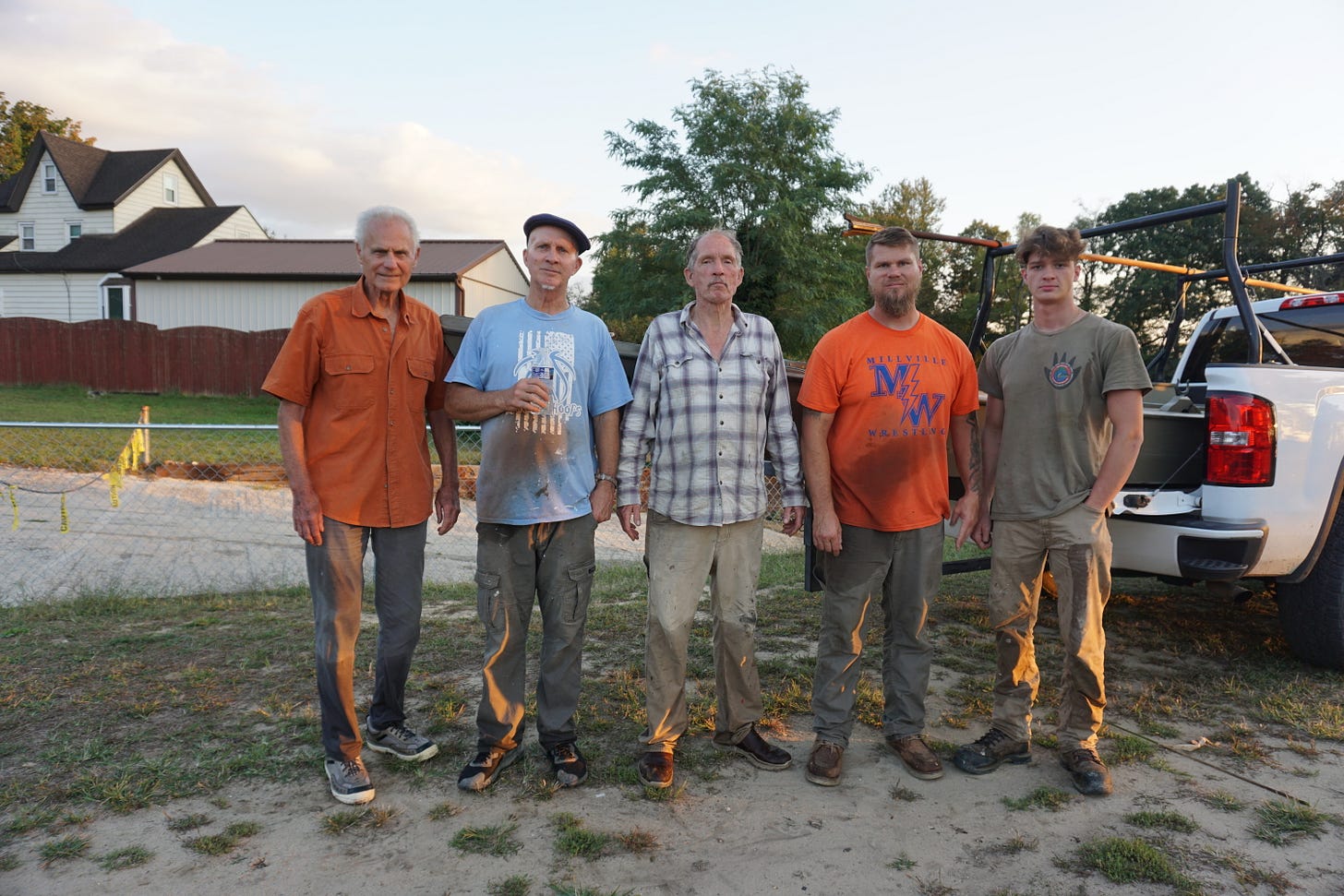
Hand and Frank Sr. keep pushing us ahead to retrieve the birds. While they do, they beat the brush, sending another bird skyward. It floats and flutters in front of me and I take shots above and below it. "Take your time," says Hand. But I'm too jacked up, fumbling to put more shells in my shotgun.
"I saw where he went down," says Frank Sr. We'll head over that way. But before we can, another bird gets up, and Frank Jr. drops it somewhere near our boat. Frank Sr. and Hand are throwing markers out like hand grenades to mark the dead birds in the water. If they didn't, we'd never find them again in all of the rice, and it's the only way to keep track of multiple birds going down in quick succession.
Soon, we run out of markers, and we split up to recover birds. By the time Hand and I get to our first, Frank Sr. and Jr. are off in another part of the marsh. We can hear more shots from their boat getting farther and farther away, along with the gunfire from White and Effington's boat in the cattails.
Learning Curve
Hand and I strike out on our own — flushing birds, shooting, and throwing markers. He spots railbirds and calls the shots from the back of the boat while I do my best to keep up. "The best part about poling is that I never miss," Hand says with a smile. "I'll give you six more shots, and then you can start pushing me."
The anticipation of every bird is what gets you as the shooter. It's like working with a bird dog in slow motion. The pusher usually knows where the bird is, and the shooter can usually see it, too. This throws off any hope of instinctive shooting because you're not exactly surprised when the bird gets up.
To make matters more difficult, you're standing on a moving platform, and the bird only flies for a few seconds before setting back down. I keep racing to beat them out of the gate and hit one before it goes back down in the marsh. In my mind, I know that if I slow down, I'll hit the bird, but my reflexes disagree.
On the next bird, I take one shot and miss, but I pause for a second as the bird circles behind us instead of pitching down into the rice. With more time to think, I swing through the bird and tumble it to the water with a splash. "There you go," says Hand. "You've got four more shots."
With my next four shots, Hand and I catch our stride. I put three more railbirds in the boat and trade him my shotgun for his push pole. It's then that I realize that poling a skiff isn't just hard physical work. It takes skill, too. You think you're going one way, but then you drift the other.
The trick is to plant one end in the mud, walk your hands up the pole, and finish with the pole behind the boat. The mud on the bottom of the marsh grabs the pole, so you need to pull it with enough force at just the right time before losing it in the water. Any subtle move from side to side will send the boat side to side. To do it well, you need a combination of finesse and strength.
While poling, I have plenty of time to think about rail bird hunting being a lost art. It isn't hard to figure out why. There's something so 19th century about it — no motors, spinning wing decoys, or other gadgets to help. It's all craft and the kind of knowledge that only gets passed down from generation to generation.
On top of that, the window to get experience hunting these birds is so small that it would take a lifetime to get good at it. There are only a handful of days to hunt per year, and just two hours each day.
It's my first time, and Hand is being patient with me as I push us around in circles. Eventually, we hit a big channel that will take us back to the mouth of the river and then the boat launch. The tide is starting to wane, and we only have minutes left before there won't be any water to float back on.
"Let's hit one more patch of cover before we head back," I say to Hand. "That's OK," he says, probably realizing it would take me forever just to get there. "You'll just have to come back next year."





